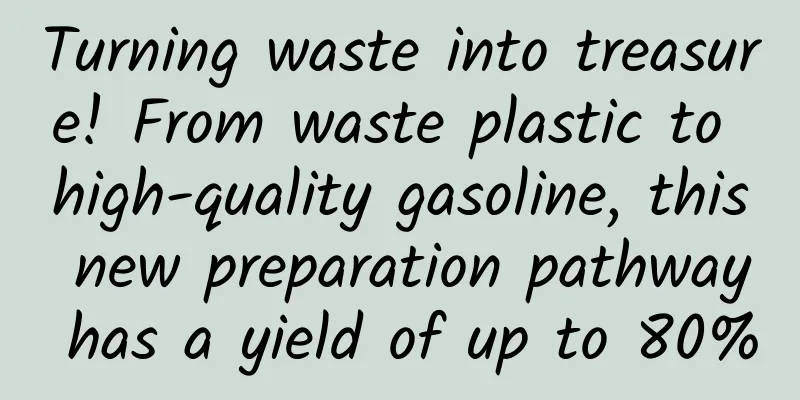Turning waste into treasure! From waste plastic to high-quality gasoline, this new preparation pathway has a yield of up to 80%

|
Produced by: Science Popularization China Author: Shi Chang (PhD in Physical Chemistry) Producer: China Science Expo Editor's note: In order to understand the latest developments in cutting-edge science and technology, the China Science Popularization Frontier Science Project has launched a series of articles titled "Understanding Top Science Journals", which selects outstanding papers from authoritative journals and interprets them in plain language as soon as possible. Let us broaden our scientific horizons and enjoy the fun of science through the window of top journals. Polyethylene plastics have become an indispensable part of our daily lives, from lightweight shopping bags to durable food packaging, from fashionable clothing to commonly used building materials, the wide application of polyethylene plastics has greatly facilitated our lives. However, the use of polyethylene plastics has also brought about a problem that cannot be ignored - the pollution of the environment by waste plastics. With the increasing use of disposable plastic products, a large amount of waste polyethylene plastics are discarded into the natural environment. These plastic wastes are difficult to degrade and will have long-term negative impacts on the soil, water sources and ecosystems. In addition, they not only pollute the environment, but also threaten the survival of wild animals and plants, and even indirectly affect human health through the food chain. So how can we achieve the environmentally friendly recycling and utilization of waste polyethylene plastics? Waste plastic (Photo source: veer photo gallery) On April 9, 2024, Chinese scientists published an article in the journal Nature Chemistry on the catalytic conversion of polyethylene plastics to produce high-quality gasoline, which is expected to achieve high-value utilization of waste polyethylene plastics. The research results were published in the journal Nature Chemistry (Image source: Nature Chemistry magazine) Strategy for turning polyethylene into gasoline The resource utilization of waste plastics can not only solve the problem of plastic pollution to the environment, but also achieve green and sustainable development of resources. Among the waste plastics, the conversion of polyethylene is very difficult, and its non-polar carbon-carbon bonds are difficult to activate and break under low temperature conditions. The existing polyethylene conversion strategies are mainly achieved under high reaction temperatures above 400°C, precious metal catalysts and external hydrogen sources. The strict reaction conditions limit the application of this strategy in industrial chemical recovery of polyethylene. Based on the problems faced by the polyvinyl alcohol conversion strategy, the researchers used tetrabutylammonium hydroxide as a structure-directing agent and a one-step hydrothermal reaction to synthesize a molecular sieve with a layered self-supporting structure (LSP) for catalytic conversion of polyethylene. Among them, the structure-directing agent is a specific ligand or additive in the process of crystal synthesis or growth, which guides the molecular assembly in the chemical reaction to form a highly crystallized ordered structure, thereby obtaining ideal physical and chemical properties. The layered self-supporting structure refers to a layered structure formed by cations and anions through ionic bonds. This structure has sufficient strength and stability between layers and can exist independently without additional support. Mesoporous channels refer to channels with pore sizes between 2-50 nanometers. These channels are between micropores and macropores, have highly ordered structures and rich surface activity, and play an important role in the performance of catalysts. The layered self-supporting molecular sieve has a larger external specific surface area and rich mesoporous channels, which can enable the reactants to fully contact the catalyst during the catalytic reaction and increase the reaction rate. Lewis acid sites refer to specific positions or regions where a chemical substance can accept electron pairs. This site can achieve the adsorption and activation of reactants, thereby achieving a catalytic effect. Compared with traditional molecular sieve materials, the layered self-supporting molecular sieve has a unique self-supporting structure and more strong Lewis acid sites. Strong Lewis acid sites and shape selectivity in molecular sieves can play a key role in catalyzing polyethylene conversion. Therefore, the layered self-supporting molecular sieve has a better effect on the catalytic conversion of polyethylene. Catalyst characterization (a. High-resolution transmission electron microscopy; b. X-ray diffraction; c. Nitrogen adsorption-desorption isotherm; d, e. NMR characterization results; f, g. IR characterization results) (Image source: Reference 1) Gasoline is mainly composed of hydrocarbons in the C4-C12 range, which is a mixture of alkanes, alkenes and cycloalkanes. The octane number is a numerical indicator to measure the anti-knock ability of gasoline in the cylinder. It is usually used to evaluate the performance of automotive gasoline. The quality of gasoline is positively correlated with the octane number. Gasoline octane rating (Photo source: veer photo gallery) The experimental results show that the layered self-supporting molecular sieve (LSP-Z100) prepared in this study can achieve the conversion of high-density polyethylene into gasoline in 4 hours at 240°C without an external hydrogen source, with a yield of more than 80%. The test results of its liquid phase product show that the C4-C12 component accounts for as high as 99%, the branched alkane accounts for 72%, and has a high research octane number (88.0), which is comparable to commercial gasoline (86.6). The above results prove that the layered self-supporting molecular sieve (LSP-Z100) has the feasibility of catalytically converting polyethylene into high-quality gasoline. This study provides a new route to solve the environmental pollution problem of waste polyethylene plastics and realize the effective utilization of resources. Conversion rate and product yield of high-density polyethylene under different catalyst conditions (Image source: Reference 1) When we think deeply about the problem of plastic pollution, it is not difficult to find that change often starts with small things. In our daily lives, reducing the use of unnecessary plastic products, such as disposable straws, plastic bags and tableware, will not only help reduce the generation of waste plastics, but also promote the improvement of environmental awareness in the whole society. In addition, garbage sorting is also a key step in reducing plastic pollution. Separating recyclable plastics from other garbage and ensuring that they are properly disposed of can not only reduce the chance of plastics entering the natural environment, but also promote the recycling of resources. Garbage classification (Photo source: veer photo gallery) References: 1.Cen, Z., Han, X., Lin, L. et al. Upcycling of polyethylene to gasoline through a self-supplied hydrogen strategy in a layered self-pillared zeolite[J]. Nature Chemistry, 2024. 2. Xie Yufei, Wang Qi, Zeng Junmin, et al. Research progress in recycling and application of waste polyethylene plastics[J]. Plastics Science and Technology, 2022. 3. Zhang Jinqing, Guo Ming, Zhang Yuanwen, et al. Research progress of waste polyethylene plastic cracking to produce fuel[J]. Petrochemical Technology, 2022. 4.Gautam KR .A Novel Process of Converting Polyethylene to Gasoline, Middle Distillate and Heavy Oil through Hydropyrolysis Route[J].International Journal of Energy Engineering, 2013. |
>>: The world is spinning...How much do you know about the medical mysteries behind vertigo?
Recommend
The four most dangerous companies after WWDC
[[136370]] Apple held its annual Worldwide Develo...
Are "panda eyes" caused by staying up late? Dark circles may be more complicated than you think...
gossip In daily life, dark circles are a problem ...
The Chang'an in the movie "30,000 Miles of Chang'an" is not the Xi'an today!
The recently released animated film "30,000 ...
OPPO N3 unboxing experience: exquisite rotating lens from inside to outside
Since N1, the rotating lens design has become OPP...
Tencent Advertising advertiser account opening qualification requirements!
Enterprise account opening qualification requirem...
Yexiseo video tutorial: Technology-driven SEO
Compared with SEO open classes, video tutorials r...
Quickly develop your own WeChat applet in two days?
Why should you learn mini program development? Wh...
APP promotion, attracting new users and activating their activity丨3 ways of thinking to awaken old users!
The Internet's demographic dividend is gradua...
Science in Poetry | Why is the air so fresh after rain?
Autumn Dusk in the Mountain Wang Wei (Tang Dynast...
Eating lychees like this is like eating bugs?
Now is the season for lychees to be on the market...
A comprehensive summary of the latest self-media monetization methods in 2017!
Q: Why do you do self-media ? Almost 10 out of 10...
Why are planetary orbits elliptical? History of the development of the theory of planetary motion
A few years ago, I casually asked an astronomer: ...
Poor traffic conversion recently? Share 8 high conversion techniques!
If you were asked to choose between the following...
Is running 800 meters a nightmare? Learn this trick to run easily
Recently, many universities have conducted physic...
A brief discussion on the principle of WeChat QR code scanning login
Preface Hello everyone, I am programmer Amu! When...









